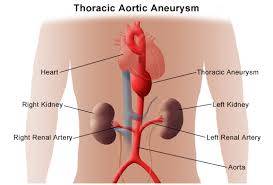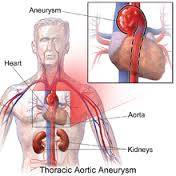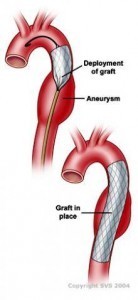CCRN Aortic Aneurysm
CCRN Aortic Aneurysm Overview
Thoracic Aortic Aneurysm
A thoracic aortic aneurysm is an aortic aneurysm that presents primarily in the thorax. A thoracic aortic aneurysm is the “ballooning” of the upper aspect of the aorta, above the diaphragm. Untreated or unrecognized they can be fatal due to dissection or “popping” of the aneurysm leading to nearly instant death. Thoracic aneurysms are less common than an abdominal aortic aneurysm. However, a syphilitic aneurysm is more likely to be a thoracic aortic aneurysm than an abdominal aortic aneurysm.
A thoracic aortic aneurysm may also be called thoracic aneurysm and aortic dissection (TAAD) because an aneurysm can lead to a tear in the artery wall (dissection) that can cause life-threatening bleeding. Small and slow-growing thoracic aortic aneurysms may not ever rupture, but large, fast-growing aneurysms may rupture. Depending on the size and growth rate of your thoracic aortic aneurysm, treatment may vary from watchful waiting to emergency surgery. Ideally, surgery for a thoracic aortic aneurysm can be planned if necessary.
Signs and Symptoms
Thoracic aortic aneurysms often grow slowly and usually without symptoms, making them difficult to detect. Some aneurysms will never rupture. Many start small and stay small, although many expand over time. How quickly an aortic aneurysm may grow is difficult to predict.
As a thoracic aortic aneurysm grows, some people may notice:
- Tenderness or pain in the chest
- Back pain
- Hoarseness
- Cough
- Shortness of breath
Aneurysms can develop anywhere along the aorta, which runs from your heart through your abdomen. When they occur in the upper part of the aorta, they are called thoracic aortic aneurysms. Aneurysms can occur anywhere in the thoracic aorta, including the ascending aorta near the heart, the aortic arch in the curve of the thoracic aorta and the descending aorta in the lower part of the thoracic aorta.
Aneurysms that form in the lower part of your aorta — called abdominal aortic aneurysms — are more common than thoracic aortic aneurysms. An aneurysm can also occur in between the upper and lower parts of your aorta. This type of aneurysm is called a thoracoabdominal aneurysm.
Causes
Factors that can contribute to an aneurysm’s development include:
- Hardening of the arteries (atherosclerosis). As plaque builds up on your artery walls, they become less flexible, and the additional pressure can cause them to weaken and bulge. High blood pressure and high cholesterol are risk factors for hardening of the arteries. This is more common in older people.
- Genetic conditions. Younger people with an ascending aortic aneurysm often have a genetic cause. People who are born with Marfan syndrome, a genetic condition that affects the connective tissue in the body, are particularly at risk of a thoracic aortic aneurysm. Those with Marfan syndrome may have a weakness in the aortic wall that makes them more susceptible to aneurysm. People with Marfan syndrome often have distinct physical traits, including tall stature, very long arms, a deformed breastbone and eye problems.Besides Marfan syndrome, other related disorders, such as Ehlers-Danlos and Loeys-Dietz syndromes, can contribute to a thoracic aortic aneurysm. Ehlers-Danlos syndrome causes your skin, joints and connective tissue to be fragile and makes your skin stretch easily.
- Other medical conditions. Inflammatory conditions, such as giant cell arteritis and Takayasu arteritis, may cause thoracic aortic aneurysms.
- Problems with your heart’s aortic valve. Sometimes people who have problems with the valve that blood flows through as it leaves your heart (aortic valve) have an increased risk of thoracic aortic aneurysm. This is mainly true for people who were born with a bicuspid aortic valve, meaning the aortic valve has only two leaflets instead of three.
- Untreated infection. Though it is a rare cause of thoracic aortic aneurysm, it’s possible to develop this condition if you’ve had an untreated infection, such as syphilis or salmonella.
- Traumatic injury. Rarely, some people who are injured in falls or motor vehicle crashes develop thoracic aortic aneurysms.
Risk Factors
Thoracic aortic aneurysm risk factors include:
- Age. Thoracic aortic aneurysms occur most often in people age 65 and older.
- Tobacco use. Tobacco use is a strong risk factor for the development of an aortic aneurysm.
- High blood pressure. Increased blood pressure damages the blood vessels in the body, raising your chances of developing an aneurysm.
- Buildup of plaques in your arteries (atherosclerosis). The buildup of fat and other substances that can damage the lining of a blood vessel (atherosclerosis) increases your risk of an aneurysm. This is a more common risk in older people.
- Family history. People who have a family history of aortic aneurysm are at increased risk of having one. People who have a family history of aneurysms tend to develop aneurysms at a younger age and are at higher risk of rupture. This is a primary risk factor in younger people.
- Marfan syndrome and related disorders. If you have Marfan syndrome or related disorders such as Loeys-Dietz syndrome or Ehlers-Danlos syndrome, you have a significantly higher risk of a thoracic aortic aneurysm.
Diagnosis
- Chest X-ray
- Echocardiogram
- CT scan of chest
- Magnetic Resonance Angiography (MRA)
Treatments
The size of the aneurysm, presence and severity of symptoms, and the risk of surgery help determine the treatment approach.
REGULAR MONITORING is standard treatment for smaller aneurysms that do not require surgery. Plan on visiting your vascular surgeon regularly—usually once a year or every 6 months, depending on the size of the aneurysm—for a computed tomography (CT) scan or MRI to check the status and growth of the aneurysm.
CONVENTIONAL SURGERY, a procedure called open thoracic aortic aneurysm repair or TAA, is done under a general anesthetic.
- Through an incision along the side of the chest, a vascular surgeon uses special surgical tools to stop blood flow in the aorta above and below the aneurysm.
- The section of the aorta with the aneurysm is replaced with an artificial graft.
- The graft is sewn in place with fine stitches, and the incision is closed.
- Most patients spend some time in the intensive care unit after surgery, and stay in the hospital 7-10 days.
ENDOVASCULAR TREATMENT is sometimes used and represents a less invasive approach. Thoracic aortic endograft repair (TEVAR) treats the aneurysm with a small device placed inside the aorta through a small incision or through puncture in the groin.
Critical Care Courses
Overview
- Elite Reviews Offers A Variety Of Online Courses That Will More Than Adequately Help Prepare The Critical Care Nurse To Pass The National Exam.
- Each Course Includes Continuing Education Credit and Sample Questions.
Continuing Education
- Each Of Our Online Courses Has Been Approved Continuing Education Contact Hours by the California Board of Nursing
- Login To Your Account In Order To Access The Course Completion Certificate Once The Course Is Complete.
CCRN Free Trial
- FREE Sample Lecture & Prep Questions
- Available For 24 Hrs After Registration
- Click Free Trial Link To Get Started – CCRN Free Trial
How It Works
How It Works
- First – Purchase The Course By Clicking On The Blue Add To Cart Button – You Will Then Be Prompted To Create A User Account.
- Second – After Creating An Account, All 3 Options (90, 120 or 150 Days) Will Be Listed. Select The Option You Desire And Delete The Other Two.
- Third – You Will Be Prompted To Pay For The Review Using PayPal – After Payment You Will Be Redirected Back To Your Account.
- Last – Click The Start Button Located Within Your Account To Begin The Program
- 150 Sample Questions
- Q & A With Rationales
- Approved For 5 CEU’s
- 90 Days Availability
- Cost $75.00
- 1250+ Sample Questions
- Q & A With Rationales
- Approved For 25 CEU’s
- 90 Days Availability
- Cost $200.00
CCRN Practice Questions Bundle
- 1350+ Sample Questions
- Q & A With Rationales
- Approved For 30 CEU’s
- 90 Days Availability
- Cost $225.00
CCRN Review Course
- Option 1
- Lectures & 1250+ Questions
- Approved For 35 CEU’s
- 90 Days Availability
- Cost $325.00
- Option 2
- Lectures & 2000+ Questions
- Approved For 40 CEU’s
- 90 Days Availability
- Cost $350.00
CCRN Review Course Bundle
- Option 3
- Lectures & 3000+ Questions
- Approved For 70 CEU’s
- 90 Days Availability
- Cost $375.00








